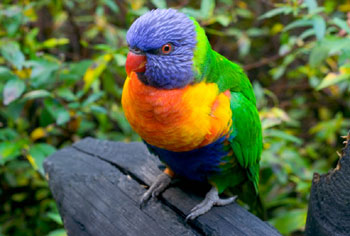 Click To Return To Main Page |
 |
||||||||
 News |
 Eco-Journalists |
 Articles |
 Games |
 Links |
 Facts 'n Fun |
 Email Us |
 About Us |
 Guestbook |
|
|
Here's an interesting story about one of Australia's most colourful birds written by Jenny Tridgell.
Here's some facts about Jenny: Name: Jenny Tridgell Age: 13 years old Favorite animal: horse Hobbies: reading, playing sport and going to the movies. School: Hills Grammar School Favourite subjects: English, history and PE. Family: brother is Stephen (15) and younger sister, Natalie (11). If I was a world leader, I would: ~ negotiate treaties for peace and an improved future for the environment. Rainbow Lorikeets
One day when my family was at Clareville Beach in Pittwater NSW, we found a young rainbow lorikeet unable to fly. If we had left it there, a cat or other carnivorous animal would have probably found and eaten the defenceless baby. The parents of the lorikeet would have been helpless to defend the baby on the ground. We took the rainbow lorikeet home in a breathable cardboard box. For a wild animal, it is remarkably calm around humans. My father’s family had cared and released about a dozen “runners”, birds unable to fly because their tail and wings are not fully grown, so this lorikeet was no exception. We named the rainbow lorikeet Honey who is settling in well into her (or his) temporary residence. As the feathers grow, we will teach Honey how to fly and, eventually release her into the wild again. A Rainbow Lorikeet
 If you find a rainbow lorikeet which is unable to fly or hurt, and you do not have a bird license or any experience, contact your local WIRES. They will give you advice or take the rainbow lorikeet off your hands. Selected local veterinarians also assist in wild bird rescues. If you find a rainbow lorikeet which is unable to fly or hurt, and you do not have a bird license or any experience, contact your local WIRES. They will give you advice or take the rainbow lorikeet off your hands. Selected local veterinarians also assist in wild bird rescues.
Rainbow lorikeets are native Australian birds which only drink nectar from flowers like grevilleas and bottlebrush and eat fresh fruit such as pears and apples. Sugars and jams are fatal to rainbow lorikeets so NEVER feed it to them. Rainbow lorikeets live in tree hollows and are covered in red, green, blue, orange and yellow feathers. Rainbow lorikeets, especially the young, are vulnerable to domestic and other introduced animals like cats. If you have a cat, be sure to watch it carefully so it does not attack baby birds. Rainbow lorikeets are beautiful multicoloured native Australian birds. By working together, we can ensure a future for them. By Jenny Tridgell |